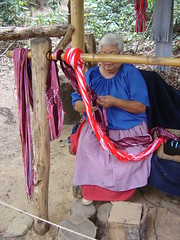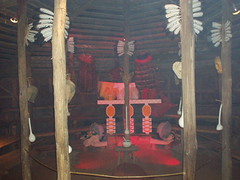American Indians in Antebellum NC
Originally published as "A Class All Their Own: American Indians in Antebellum North Carolina"
by Sydney Nathans
Reprinted with permission from the Tar Heel Junior Historian. Fall 1996; Revised October, 2022.
Tar Heel Junior Historian Association, NC Museum of History
 The Cherokee tribe of American Indians had lived in what we now call the Appalachian Mountains for thousands of years. Much of their land was primarily valuable forests and fertile farmlands that were desired by the white pioneers and settlers who were moving westward in the early 1800s.
The Cherokee tribe of American Indians had lived in what we now call the Appalachian Mountains for thousands of years. Much of their land was primarily valuable forests and fertile farmlands that were desired by the white pioneers and settlers who were moving westward in the early 1800s.
Adapting to White Culture?
Before the antebellum period began in roughly 1830, these Cherokee had already begun to create a new, modern society governed much like the United States. They created a constitution modeled after America’s Constitution and adopted three branches of government. They divided their land into districts and chose representatives, who attended sessions at a capital in New Echota, a town in present-day Gordon County, Georgia. They even built a capitol building using popular American architectural styles.
 This was the new Cherokee Nation, which consisted of American Indians in parts of northern Georgia, northeastern Alabama, eastern Tennessee, and extreme western North Carolina. Residents of this new nation quickly adopted parts of the local white culture.
This was the new Cherokee Nation, which consisted of American Indians in parts of northern Georgia, northeastern Alabama, eastern Tennessee, and extreme western North Carolina. Residents of this new nation quickly adopted parts of the local white culture.
Outside the boundaries of this Cherokee Nation, however, lived the Oconaluftee Cherokee of North Carolina, ancestors of today’s Qualla Boundary Cherokee. They lived on mountainous land the United States allowed them to keep under terms of an 1819 treaty. The Oconaluftee Cherokee were described as "wild" because they resisted adopting white ways. More likely, they failed to adopt white ways because they were somewhat isolated and had less contact with whites who might have influenced them. These Oconaluftee Cherokee were never serious candidates for forced removal in 1838 and remained in the mountains on their 1819 treaty land.
North Carolina’s Cherokee of the Antebellum Period
Soon after 1838, the majority of North Carolina’s Cherokee were on their way to becoming "more white" so they could better fit into society and not risk removal from their land at a later time. Most, for example, had already started living as single families instead of in clans even before the removal. And while some of the remaining Cherokee had become university educated and lived in fine homes with many enslaved people, most were making their homes in windowless log cabins very similar to those of the state’s poor white class. Their cabins typically measured about thirteen feet by thirteen feet and had dirt floors and chimneys made of sticks and clay.
Some antebellum Cherokee farmers, not unlike white farmers of the time, exhibited a stubborn resistance to change and were slow to learn scientific farming methods. Many practiced primitive levels of subsistence agriculture without benefit of the labor of enslaved people or modern implements. They often occupied farms averaging just under ten acres that were situated in river and creek valleys where they could grow corn, tend small orchards of apple and peach trees, and raise pigs, sheep, and cattle.
Cherokee food and clothing of this time reflected a mixture of Indian and white cultures. Standard foods included traditional Indian dishes like corn grits, bean bread, squash, fish, game animals, and berries, nuts, and other wild plants such as ramps (a kind of onion). European foods included beef and pork, as well as Indian dishes prepared in a  European manner like corn bread and corn cakes fried in bear grease. Clothing combined traditional dress of the Cherokee with styles worn by their poor white neighbors. Cherokee women made this clothing at home and added their own finishing touches—they displayed a fondness for color in the form of bright turbans, shawls, handkerchiefs, feathers, scarlet belts, and hunting shirts. Their unique style was sometimes described as Turkish. Moccasins were still the preferred footwear.
European manner like corn bread and corn cakes fried in bear grease. Clothing combined traditional dress of the Cherokee with styles worn by their poor white neighbors. Cherokee women made this clothing at home and added their own finishing touches—they displayed a fondness for color in the form of bright turbans, shawls, handkerchiefs, feathers, scarlet belts, and hunting shirts. Their unique style was sometimes described as Turkish. Moccasins were still the preferred footwear.
Perhaps the largest change in post-removal life and the biggest move toward becoming more white concerned religion. Late in the antebellum period, a few Cherokee began converting to a kind of Christianity. In earlier days, Chief Yonaguska (also spelled Eoneguski) had discouraged adoption of the white man’s religion. Interestingly, he thought that Christian theology embodied some wonderful concepts and ideas. But he noted that white behavior and actions often did not reflect those beliefs. If the whites did not live by their own religion, he felt, it was probably not worth much.
Additional Resources:
DocSouth: Native American History in North Carolina. https://docsouth.unc.edu/highlights/nativeamericans.html
Museum of the Cherokee Indian. http://www.cherokeemuseum.org/
Image Credits:
September 25, 2010. Cherokee, NC. "Cherokee, NC: Oconaluftee Indian Village.". Located at https://www.flickr.com/photos/harry_nl/5146045643/. Accessed February 24, 2012.
Eklund, Mary Louise. June 22, 2002. "Cherokee Council Chamber.". Located at https://www.flickr.com/photos/mleklund/6663607223/. Accessed February 24, 2012.
Hamill, David. October 20, 2009. "Cherokee - North Carolina - October 2009." Located at https://www.flickr.com/photos/auldhippo/5128653663/. Accessed February 24, 2012.
Hamill, David. October 20,2009. "Cherokee - North Carolina - October 2009". Located at https://www.flickr.com/photos/auldhippo/5129261820/. Accessed February 24, 2012.
1 January 1996 | Nathans, Sydney
